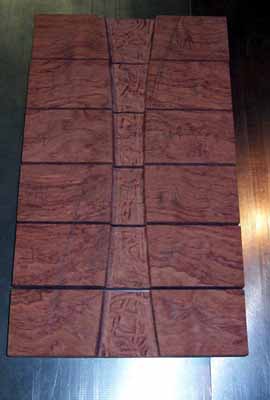With a little imagination you can picture
these are drawer fronts in a box.
I am going to leave that curvy texture just
like it is...
I can imagine all kinds of neat ways to use
this effect... but I suspect a little bit
of the look will go a long ways.
Now I just hope to not bungle the half-blind
dovetails in that hard-as-a-rock Bubinga.
I'm going to call it 'router texturing'.
It looks way better in real life than that photo
shows... I'm fired up about it.
When those drawers get fitted into a little box where
every other surface is pristine smooth... I believe the
visual and tactile impact of the router texturing is
really going to set the box off.
That... or people will go running out of my show booth
screaming that I'm an idiot.
I hit the fuzzy spots with some 320 sandpaper and I'm
going to leave it just like that.
Thanks for listening.
Knipfer
Comment from daglenn1960:
Not to be a 'parade rainer' but this effect has
been used in more recent times by sign makers
(using routers) to emulate much older sign carving
techniques.
You will see it pretty extensively in stone carving
as well.
I don't know if it has a name (background texturing?)
but it looks quite nice.
Sign (router) carvers do it much the same way,
though often with a 'theme' in mind (cross hatching,
regular squiggles, etc.) with various bits
(round, v, etc.).
~dave
Knipfer response:
Hey... Welcome to the WWA Dave.
Just goes to show (again) that after 5000
years of WW there is nothing 'new'.
You are not raining on my parade... I'm tickled
to have come across the technique quite by
accident, and am pleased to hear that it has
in fact some current applications.
My squiggles were kind of random with no theme
in mind at all.
Thanks for pitching in with that history of the idea.
Knipfer
|

|
|



